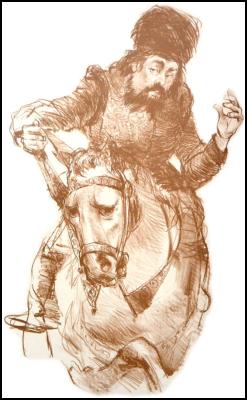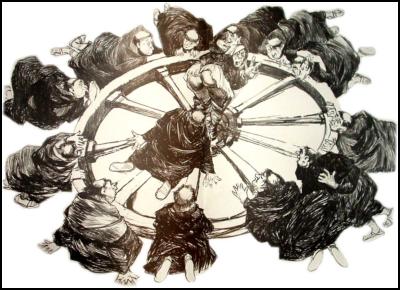The Rescue Of Deuss' Visionary Canterbury Tales
The Rescue Of John Deuss' Visionary Canterbury Tales: Les Travers Interview
By Suzan Mazur

Click for big version
The merchant? – Image From
]thecanterburypilgrim.com
"John Deuss, multi-millionaire Dutch oil man and, until recently, chairman of Bermuda Commercial Bank, is being questioned in his native Netherlands about "carousel" financial irregularities involving his Curacao bank. So what, you would be pardoned for asking, has that to do with Chaucer's famous stories?
Image From thecanterburypilgrim.comDeuss is surely a latter-day merchant telling tales as did his medieval forerunner. Someone who might, if the world's banking authorities succeed, have good reason to walk his own pilgrim's way and pray forgiveness.
But hold fast before you condemn him to sack-cloth and ashes! What crime has he committed? None, if his vehement denials are true. And there are many who believe he has been unfairly singled out in the search for a scapegoat.
Advertisement - scroll to continue readingYet he is now thrust into the limelight as some kind of international fraudster instead of basking in the glowing reputation of literary benefactor; for that was surely his destiny had he not himself been cruelly robbed. John Deuss had a vision that, thanks to his hard-earned wealth, almost materialized on the long road to reality." Les Travers, www.thecanteburypilgrim.com
Suzan Mazur: What prompted John Deuss to commission the Canterbury Tales project?
Les Travers: I've never had a chance to ask him, never met him. But I've been told that Deuss admired Geoffrey Chaucer's work and the late Charles Mozley's artistic skills. Mozley was indeed one of England's finest illustrators, known also for his magnificent horses in Black Beauty. The Mozley Canterbury drawings are a joy to see, undoubtedly the best version of the Tales ever produced.
Had the project been completed, there is no doubt it would have been the literary work of the century.
The Tales were translated by Nevill Coghill and illustrated by Mozley in the 1980s -- one thousand copies, a massive elephant folio sized, set to grace a thousand universities and libraries around the world thanks only to Deuss' amazing generosity. Until, that is, Mozley's death prevented completion, bringing ten years of devoted labor and over three hundred illustrations to an end.
Because of circumstances outwith Deuss' control, the four folios and eight tales that had been printed were eventually stored in a barn. An old barn; a falling-down kind of barn. And they suffered a decade of attack by harsh English winters and hungry, marauding mice . . . until someone remembered where they were!
But without Deuss, Tales would simply not have happened. It is a literary heritage to be admired not only by generation after generation of Chaucer devotees, but also medieval scholars who see the Canterbury Tales as the social comment they truly were.
I doubt John Deuss will ever receive the accolades he deserves for this project, and perhaps in his present circumstances it is not the most important aspect of his life, but that does not diminish what he intended to give the world. Perhaps, like Chaucer, he will survive the many accusations thrown at him. There are many people here in England who truly hope so and wish him well.
Suzan Mazur: How did it all start?
Les Travers: It all started after I returned from Africa where I'd spent a few years taking clients on safari -- a relaxed pastime after many years in personal security, my field of expertise. I learned that my son, Kes, then 16-years old, had been approached by a friend who knew of this almost unbelievable store of Canterbury Tales folios.
Kes was simply intrigued at first, but he also knew of my English college studies -- of Chaucer in particular. My choice of studies was influenced by my schooling in Canterbury, yet it was not the entire reason.
Geoffrey Chaucer, after all, was the father of English literature and certainly as influential as the later William Shakespeare. Who knows, had Chaucer not started the practice of writing in English, perhaps Romeo and Juliet would have been an Italian tragedy written in French! Chaucer's death is commemorated on October 25th, by the way.
Suzan Mazur: Where was the barn where the drawings were found?
Les Travers: In Kent. When I saw the art, I was overwhelmed. I decided Kes had to be helped to rescue the Tales.
We managed to buy what was essentially a mountain of wet and rodent ravaged paper. Then Kes took on the responsibility of salvaging as much of the complete work as possible before turning his attention to saving individual lithographs where the text had been destroyed. After two years of hard labor, we now have two hundred complete sets and enough lithographs to set up a permanent exhibition in Canterbury, which will preview during a US tour in 2007.The exhibition and its collection of pilgrim artifacts, including a rare Becket ampulla (one of only seven in the world) will surely be one of Canterbury's foremost attractions.
There is an enormous interest in both Chaucer and his tales in the US. In San Francisco there is a Chaucer theater company and also a Canterbury Tales-themed hotel. We are liaising with the theater to put on an exhibition, which I hope will include staged plays of the Tales. We'd like to repeat the theater production in Canterbury.
Suzan Mazur: Why do you suppose John Deuss was fascinated by Chaucer?
Les Travers: Maybe Chaucer's similarly VERY complex character. No one knows very much about Chaucer's early life either. Chaucer comes to the fore when he enters the outer circle of royal court life, becoming a page for the wife of the Duke of Clarence.
He later takes up arms against the French, but is captured at the battle of Rettel, causing a ransom to be paid by King Edward III. Then he goes on to marry Philippa, the sister of Katherine de Roet -- who became the wife of John of Gaunt, son of Edward III and the most powerful man in England.
Chaucer chose wisely to enter John of Gaunt's service!
When John of Gaunt's wife died of plague, she was commemorated by one of Chaucer's most beautiful poems, The Book of the Duchess. Chaucer then carried out military and diplomatic missions to France, Flanders, Spain and Italy -- and accrued more power. After returning to England, he was appointed Justice of the Peace and elected to the House of Parliament as MP for Kent.
Still influential at the royal court, he became a favorite of the Earl of Derby, son of John of Gaunt, who later became King Henry IV.
It was during this time that the Canterbury Tales was started -- the stories of pilgrims 800 years ago en route to Canterbury to the tomb of Thomas Becket.
Towards the end of Chaucer's life, turmoil spread all over England, resulting in the murder of John of Gaunt's brother on the orders of Richard II, who himself was later murdered. And Henry took the throne.
Even more chaos followed. Chaucer tried to retire from public life. But sometime during 1400, he either disappeared or died. His tomb is in Westminster Abbey, however, many are unconvinced Chaucer actually resides within!
So Chaucer, like Deuss, was extremely complex. Chaucer made many enemies even with his writing of the Tales. He used the Tales as barbed comments on the state of the country -- especially targeting the church.
Of course, his fictional characters could not be prosecuted. But no one was fooled! And had Chaucer not surrounded himself with powerful people there is little doubt that he would not have survived so long.
Suzan Mazur: Parallels to the current Deuss saga?
Les Travers: Chaucer even survived unscathed from a FALSE charge of rape.
But again Deuss, as visionary and benefactor of the Mozley-Coghill Chaucer tales -- even uncompleted -- has given us one of the really important literary works. The eight tales are an absolute collector's item. Despite the lost folios, many can enjoy owning the individual lithographs that have been saved.
This is the idea behind our planned exhibition and where better to site it than Canterbury? Still attracting more than two million pilgrims every year.
 Suzan
Mazur's reports have appeared in the Financial Times,
Economist, Forbes, Newsday, Philadelphia Inquirer, Bermuda's
Mid Ocean News, CounterPunch and Scoop, among others, as
well as on PBS, CBC and MBC. She has been a guest on
McLaughlin, Charlie Rose and various Fox Television News
programs. Email:
sznmzr@aol.com
Suzan
Mazur's reports have appeared in the Financial Times,
Economist, Forbes, Newsday, Philadelphia Inquirer, Bermuda's
Mid Ocean News, CounterPunch and Scoop, among others, as
well as on PBS, CBC and MBC. She has been a guest on
McLaughlin, Charlie Rose and various Fox Television News
programs. Email:
sznmzr@aol.com



 Peter Dunne: Luxon Gets Out His Butcher's Knife - Briefly
Peter Dunne: Luxon Gets Out His Butcher's Knife - Briefly Binoy Kampmark: Warring Against Encryption, Australia Is Coming For Your Communications
Binoy Kampmark: Warring Against Encryption, Australia Is Coming For Your Communications Gordon Campbell: On Fast Track Powers, Media Woes And The Tiktok Ban
Gordon Campbell: On Fast Track Powers, Media Woes And The Tiktok Ban Binoy Kampmark: Censorship Wars, Elon Musk, Safety Commissioners And Violent Content
Binoy Kampmark: Censorship Wars, Elon Musk, Safety Commissioners And Violent Content Gordon Campbell: On The Public Sector Carnage, And Misogyny As Terrorism
Gordon Campbell: On The Public Sector Carnage, And Misogyny As Terrorism Ramzy Baroud: NATO’s Never-ending War: The 75-Year-Old Bully Is Faltering
Ramzy Baroud: NATO’s Never-ending War: The 75-Year-Old Bully Is Faltering